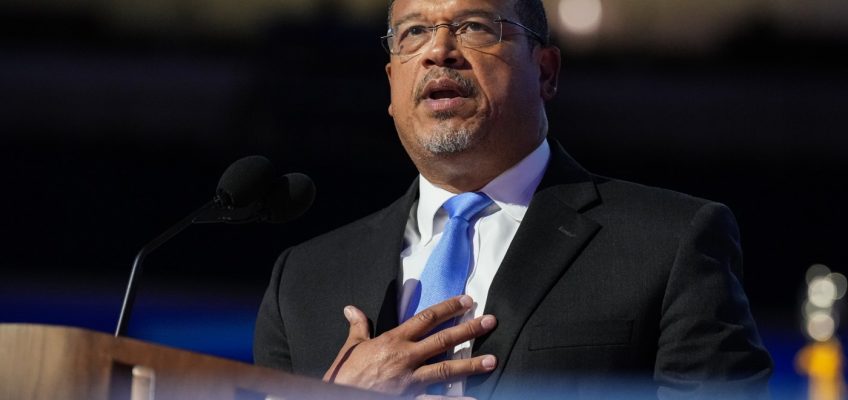By Lauren Sausser, KFF Health News
For nearly three years, Eric Tennant endured chemotherapy infusions, rounds of radiation, biopsies, and hospitalizations that left him weak and depleted.
Cancer stole her voice. She used AI, curse words and kids’ books to get it back
They met at a St. Paul hospital. After emerging from comas. They’re getting married.
Keith Ellison names team to assist renewed UMN/Fairview negotiations
US vaccine advisers say not all babies need a hepatitis B shot at birth
‘We can’t just teach abstinence’: How advice on bed-sharing with a baby is evolving
“It’s good to be home,” he said after one hospital stay in early June, “yet I’m tired and ready to get on with things.”
In 2023, Tennant, of Bridgeport, West Virginia, was diagnosed with cholangiocarcinoma, a rare cancer of the bile ducts that had spread throughout his body.
None of the initial treatments prescribed by his doctors had eradicated the cancer. But a glimmer of hope came in early 2025, when Tennant was recommended for histotripsy, a relatively new procedure that would use ultrasound waves to target, and potentially destroy, the largest tumor in his body — in his liver.
“My dad was a little nervous because it was something new, but it definitely gave us some hope that he would be around a little bit longer,” said Tennant’s daughter, Amiya.
Amiya Tennant takes a family photo with her mom, Becky; dad, Eric; brother, Arryn; and sister-in-law, Jaimee, at her parents’ home in Bridgeport, West Virginia. (Amiya Tennant/Amiya Tennant/TNS)
There was just one hitch: His insurer wouldn’t pay for it.
Tennant, 58, died of cancer on Sept. 17. His story illustrates how a bureaucratic process called prior authorization can devastate patients and their families.
It’s infeasible to count the people harmed by this overwhelmingly unpopular practice, which, by delaying or denying care, helps drive health insurers’ profits. No government agency or private group tracks such data.
That said, KFF Health News has heard from hundreds of patients in recent years who claim that they or someone in their family has been harmed by prior authorization. More than 1 in 4 physicians surveyed by the American Medical Association last December said that prior authorization had led to a serious adverse event for a patient in their care. And 8% responded that prior authorization led to a disability, birth defect or death.
In June, the Trump administration announced a pledge, signed by dozens of private insurers, to streamline prior authorization, which often requires patients or their medical teams to ask insurers for permission before proceeding with many types of care. It remains unclear when patients can expect to see improvement.
The commitments “depend on the full cooperation of the private insurance sector” and will “take time to achieve their full effect,” said Andrew Nixon, a spokesperson for the Department of Health and Human Services. But the pledge exists, he said, “to prevent tragic deaths like Eric’s from occurring at the hands of an inefficient system.”
Chris Bond, a spokesperson for AHIP, a health insurance industry trade group, said he could not speak to any specific insurer’s prior authorization policies. Broadly, though, he said prior authorization “acts as a guardrail” to make sure medicines and treatments are not used inappropriately.
At the same time, he said, insurers recognize that patients can be frustrated when their doctor-recommended care is denied. That’s why “there is a dedicated effort across the industry to make the process more straightforward, faster, and simpler for patients and providers,” Bond said.
For months, Eric Tennant’ s health insurer refused to cover a cancer treatment recommended by his doctor, claiming the procedure was“ not medically necessary,” a common reason used by insurers to deny care. (NBC News/NBC News/TNS)
In the meantime, the process continues to take its toll on people like Eric Tennant, whose grave diagnoses often require expensive health care services.
“Eric is gone,” his widow, Becky, said. “He’s not coming back.”
Tennant was a safety instructor for the West Virginia Office of Miners’ Health Safety and Training and insured by the state’s Public Employees Insurance Agency, which contracts with UnitedHealthcare to administer benefits for state employees, their spouses, and dependents.
In February and March, UnitedHealthcare, the Public Employees Insurance Agency, and an outside reviewer issued a series of denials that concluded Eric’s benefits would not cover histotripsy, claiming the treatment was not medically necessary. Becky Tennant estimated the procedure would cost the family about $50,000 out-of-pocket.
Although the treatment wasn’t guaranteed to work, it was worth a shot, the Tennants thought, so they considered withdrawing money from their retirement savings. But then, in May, after KFF Health News and NBC News posed a series of questions to UnitedHealthcare and the Public Employees Insurance Agency about Eric’s case, the agency reversed course. PEIA decided to cover his treatment.
Notably, the agency contacted KFF Health News about the approval hours before it notified the Tennant family of the decision.
But the approval came too late. Eric was hospitalized in late May and prescribed medication that prevented him from undergoing histotripsy at that time. His family held out hope that his health would improve and he would qualify for the procedure that summer.
In July, Eric Tennant took one last vacation with his family to Marco Island, Florida: his daughter, Amiya; wife, Becky; daughter-in-law, Jaimee; and son, Arryn. (Jaimee Tennant/Jaimee Tennant/TNS)
In July, they took a family vacation to Marco Island, Florida. It would be their last. Two days after they returned home, a scan revealed Eric’s cancer had continued to spread. Histotripsy was out of the question.
“I’m sad for what we will miss out on,” Becky said. “I’m sad at the unfairness of it.”
She said if Eric had been able to undergo histotripsy in February, as originally recommended by his doctor, it might have destroyed the tumor in his liver that ultimately killed him.
Eric Tennant at home in Bridgeport, West Virginia. (Rebecca Tennant/Rebecca Tennant/TNS)
“We’ll never know. That’s the thing. Any lawyer for the insurance will say, ‘Well, you don’t know it would have helped.’ No. You took that chance away from us,” she said.
In October, Samantha Knapp, a spokesperson for the West Virginia Department of Administration, told KFF Health News that the Public Employees Insurance Agency has not changed its policies related to prior authorization for histotripsy and continues to follow UnitedHealthcare’s guidelines.
UnitedHealthcare declined to answer questions for this article.
Eric and Becky Tennant rest in Eric’s hospice bed with their dog, Molly. Eric died at home of cancer on Sept. 17. (Amiya Tennant/Amiya Tennant/TNS)
On Sept. 17, in a hospice bed set up in their dining room, Eric was surrounded by his family and their dogs as he died. Becky held his hand as his heart rate began to drop.
“He wasn’t afraid to die, but he didn’t want to die,” she said. “And you could tell the last day that he was fighting it big time.”
At the very end, she whispered in his ear: “You know I love you. You have been the best husband and the best dad, and you’ve always taken such good care of us,” Becky recalled.
And then, she said, he gasped. His eyebrows seemed to shoot up in wonder. During his last moment alive, she said, he smiled.
“The look on his face was pure, total amazement,” she said. “I still can’t believe he’s not here.”
©2025 KFF Health News. Distributed by Tribune Content Agency, LLC.




